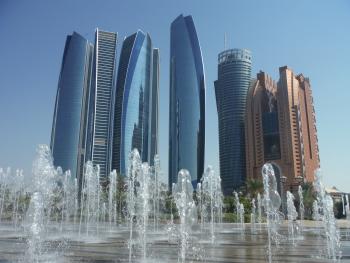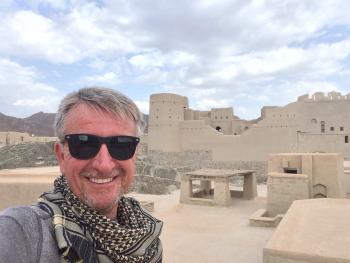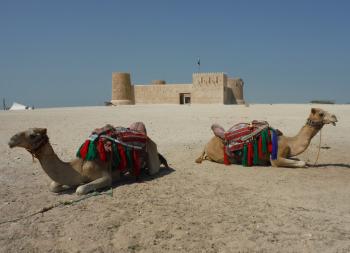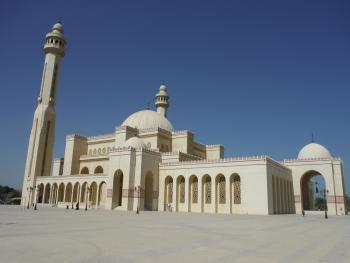Captivated by the landscapes and lifestyle in the ‘Arab Sheikdoms’ of the Persian Gulf
This article appears on page 18 of the February 2018 issue.
I had visited and admired many Muslim countries, but I had yet to observe daily life in the Gulf nations, which pair great wealth and deep conviction to Islam and have played a critical role in world history, both past and present.
My 15-day “Arab Sheikdoms” tour in October 2016 with Bestway Tours & Safaris (Vancouver, BC, Canada; 800/663-0844, www.bestway.com) took me to five vibrant countries I had never seen before: Kuwait, Bahrain, Qatar, Oman and all seven members of the United Arab Emirates. Bestway was the only company I found that combined all those countries into one sensible and reasonably priced itinerary.
The touring experience
As an intrepid traveler, I usually optimize my experience abroad by engaging local guides and companies to handle day-to-day logistics. In my visit to the Gulf countries, Bestway arranged all hotels, flights, ground transportation and other details.
They arranged for me to have a different local guide in each country, and each guide was friendly, professional, knowledgeable, reliable and punctual. The guides really listened to my particular interests and then tailored the experiences to my preferences, even when that involved lingering longer than originally planned at museums, mosques and mountains.
For nearly two months before arriving for the tour, I traveled in rougher areas of the Middle East, so once I embarked on the tour, I felt like I could take a big breath and relax. The tour included first-class accommodations that easily met Western standards, and I got to enjoy local food specialties in each country we visited.
With visas and other challenges, the Gulf states can be a difficult place to travel. Using a prearranged tour made this otherwise-complex journey feel simple. All I had to do was step out of my luxury hotel and greet my friendly guide. He or she then handed me a cool bottle of water, settled me into a comfortable seat and whisked me to one amazing adventure after another.
Oman and Kuwait
I started my journey in Muscat, the capital of Oman. Muscat offers a unique blend of ancient and modern architecture. Among the highlights were the Grand Mosque, a stunning, modern Islamic place of worship that can accommodate up to 20,000 people, and Al Alam Palace, one of the official residences of Sultan Qaboos.
One tip for travelers new to the Middle East — both men and women need to wear sleeved shirts and cover their legs, and women must wear a head scarf when visiting Islamic holy sites.
An exciting part of my time in Oman was an excursion based around Nizwa, one of the oldest cities in the country. On the day trip, we visited a variety of Omani towers, castles and forts. We also saw Jabreen, which some say is one of the most beautiful of the Omani castles, and the Bahla Fort ruins. This UNESCO World Heritage Site was built by the Banu Nabhan tribe, who made Bahla their capital from the 12th century to the end of the 15th.
Next, we flew from Muscat to Kuwait for a short 2-night stay. Kuwait is a busy country known for its oil industry. On the one full day I spent there, I visited the Kuwait National Museum, Al-Bader House and Sadu House. These provided a unique insight into Kuwait’s opulent history, with examples of handicrafts, archaeological artifacts and rare Islamic books.
Bahrain and Qatar
After a short flight, I touched down in Bahrain, an island kingdom that has moved beyond its roots as a British protectorate.
There, my guide and I shared an experience that stays vivid in my memory. In the morning, we visited the Al Fateh Grand Mosque, where I was given a very personal presentation on Islam. Then we walked through the Bahrain National Museum, which depicts local cultures over 6,000 years old.
Transitioning from history to the present moment, we went next to the Royal Camel Farm, which had about 175 camels; some of them nuzzled my arms.
We ended the day at the Bahrain Fort, which dates back to 2300 BC. As the sun set, my guide, Lunghei, surprised me by singing a folk song about the goodness of people who remain constant in life. The soft music wrapped around me like a warm blanket in the cooling night air of another unforgettable day.
Moving on from Bahrain, I arrived in Doha, Qatar. This city boasts one of the highest incomes per capita on Earth, and the wealth shines through in its stunning buildings. One particularly memorable stop was the traditional Old Souk (Souq Waqif), which sells spices, fabric, perfume, art and even Arabian falcons.
Exploring the UAE
The remainder of my trip was spent in the United Arab Emirates. After flying in to the capital, Abu Dhabi, I spent time in each of the emirates: Abu Dhabi, Ajman, Dubai, Fujairah, Ras al-Khaimah, Sharjah and Umm al-Quwain.
The Gulf states feature some of the most modern and wealthy cities in the world, and perhaps the most well known of the emirates, Dubai, is a stunning example of this wealth, featuring Palm Islands, the Burj Al Arab hotel (built in the shape of a ship’s sail), which claims to be the most luxurious hotel on Earth, and the towering Burj Khalifa, the tallest building in the world.
Despite these attractions, the greatest highlight of the Sheikdoms tour for me was the endless Arabian Desert. From flowing sand dunes to the hard-baked scrabble dotted with acacia trees and saltbushes, desert framed the cities, dominated the landscapes and transformed the soul.
Outside Dubai, I was in heaven during a late-afternoon jeep safari, drifting through mountain-high pink sand dunes. That adventure concluded with a camel ride, a Bedouin meal and a cultural show complete with belly dancers under a night sky of infinite stars.
My growing feelings of fascination with the desert crystalized as I walked the stone corridors of the Al Jahili Fort in Al Ain and encountered an inspiring display of photographs and quotes by the British explorer Wilfred Thesiger, also known as “Mubarak bin London,” Arabic for “the blessed one from London.”
Thesiger’s words written there spoke to my soul: “In the desert I had found a freedom unattainable in civilization; a life unhampered by possessions, since everything that was not a necessity was an encumbrance. I had found too, a comradeship inherent in the circumstances, and the belief that tranquility was to be found there.”
In that museum, I encountered a black-and-white photo that instantly became a new favorite. It depicts a Bedouin wearing a turban and dressed in a white flowing thobe stretching to his wrists and ankles. A rifle is slung on his shoulder and a saluki hunting dog is by his side. Both are facing away from the camera and staring out at the Hamra sand dunes, which stretch to the horizon like waves in the sea.
When I saw this image, a feeling surged within my chest, and I thought, ‘That’s what I want out of life.’
Final observations
I would highly recommend Bestway’s “Arab Sheikdoms” tour to everyone who is looking for new lands to explore and has an interest in the Gulf states’ amazing architecture, delicious food, ancient culture and magnificent deserts.
Although I’ve been to many Muslim countries, I have never experienced more informative presentations for Westerners about Islam than were available from the friendly, English-speaking hosts at Al Jumeirah Mosque in Dubai, the Spiral Mosque at Qatar Islamic Cultural Center in Doha and the Fateh Grand Mosque in Bahrain.
Of course, if you like luxury, entertainment, food and shopping, the Gulf states have it all. You can buy anything from footwear to falcons in the narrow alleys of Doha’s Souq Waqif market, and you can ice skate, snow ski and scuba dive in the comfort of Dubai’s air-conditioned shopping malls.
This tour ($6,720, land only) was busy but not exhausting, and the itinerary was appropriate for adults of nearly all ages. Anyone with reasonable stamina and mobility should be just fine.
Just be aware that if you visit the Arab sheikdoms, you may be forever transformed. Thesiger’s words about desert life capture this transformation perfectly: “No man can live this life and emerge unchanged. He will carry, however faint, the imprint of the desert, the brand which marks the nomad; and he will have within him the yearning to return….”




